The quota reform movement started on the first day of July 2024. At first, it was termed a quota reform movement, but gradually it became an anti-quota as well as an anti-government movement fuelled by some opportunistic political powers. Thus, it started as a non-violent movement but became one of the most violent movements in the history of Bangladesh. Unprecedented turmoil was seen when fundamentalist parties like BNP and Jamaat decided to stage demonstrations aligning with the quota movement.
Although most of the quota was scaled back by a government ruling, the protestors continued to instigate violence under the cloak of the student movement. It seems more horror is waiting for the country; as fundamentalist groups are orchestrating the current mayhem. The quota reform protests, which have been ongoing for several years, represent a broader discontent within Bangladesh’s youth regarding employment opportunities and fairness in public sector recruitment. The students’ demands were straightforward: Abolish this quota and give jobs on merit. They argued that the system failed to reflect the needs and aspirations of contemporary Bangladesh. Moreover, this movement can be regarded as successful in light of the Supreme Court’s decision to reform the quota system in government, semi-government, and autonomous bodies.
Advertisement
The Supreme Court ordered a reduction in the freedom fighters’ quota from 30 to 5 five per cent, with 93 per cent of jobs to be awarded on merit. The decision was welcomed, even though it took longer than anticipated, given the current political and social unrest. While students in general cautiously welcomed this decision, it was not enough to quell the unrest. Several vested groups snatched the movement from students and started demanding more and more. Students Against Discrimination, the leading group behind the protests, asked people to stop paying taxes and utility bills to pile pressure on the government under the influence of opposition parties.
They also asked government workers and labourers in the country’s economically vital garment factories to strike. Thus, the student protest started with a demand to abolish quotas in civil service jobs last month and then turned into a broader anti-government movement. The anti-government movement resulted in widespread violence and instability across Bangladesh, killing hundreds of people and injuring thousands more. Furthermore, the attempts to destroy the country’s mass infrastructures and other violent episodes that occurred during the protests highlighted the depth of the danger. Over the past few days, numerous significant locations in the capital were subjected to vandalism and arson. The terrorists attacked the structures which showcased the government’s successes. These perpetrators’ activities prompted the government to deploy the armed forces to support the civil administration in restoring law and order nationwide and to impose a nationwide curfew.
The Army’s deployment was calculated to strengthen the civil administration’s ability to handle a complex and unstable situation. The troops were taken only to protect public safety and prevent violence from worsening. Peace had returned until the BNP-Jamaat started orchestrating a violence. It is worth mentioning that Jamaat-Shibir terrorists initially maintained a low profile, infiltrating the quota reform movement. Later, they came to the forefront. Their motive was never quota reform but to topple the government. The Bangladesh Nationalist Party (BNP) and the Jamaat-e-Islami Bangladesh instigated violence under the cloak of the student movement. On 4 August, these terrorists targeted and attacked Bangladesh Awami League offices, law enforcement agents, journalists, and civilians. To secure the unconstitutional fall of a government, the militants attacked, burnt, vandalized, and looted houses of Al leaders, offices of police and the administration, and some hospitals across the country.
Not only that, these perpetrators attacked and looted various minority properties and killed a prominent Hindu leader and local councilor, Haradhan Ray, in Rangpur. They also attacked several journalists and killed a local journalist, Prodip Kumar Bhaumik, in Sirajganj. Their brutality reached its peak when at least 13 policemen were killed in Sirajganj’s Enayetpur police station. At around 11 am, some 3,000-4,000 protestors and BNP-Jamaat activists started vandalizing areas surrounding the police station. Later, they entered the police station and attacked the police officers. Police officers were severely beaten and seriously injured with locally made weapons and batons. Many died without treatment at the police station premises.
This shows the ultimate picture of human rights violations by fundamentalist groups, which shocked the whole country. These are not exhaustive lists; more information is still coming in about killings and destructions. This is not politics. The criminals are not students. They are terrorists, and they must be stopped. The international community must take note of these terrorist and violent acts. Unfortunately, global media portrayed a very one-sided picture of the events. Bangladesh will be in the hands of the fundamentalists again.
(The writer is a Dhaka-based human rights activist and writer.)











